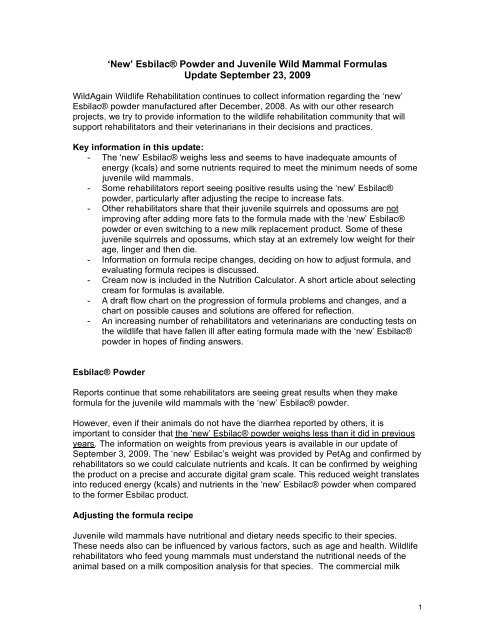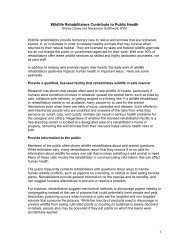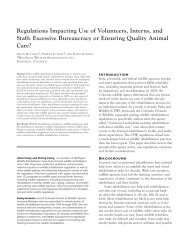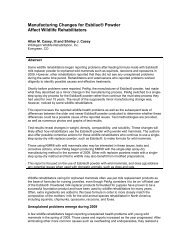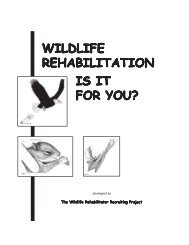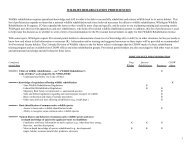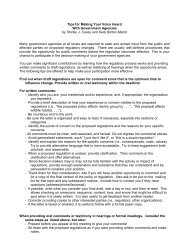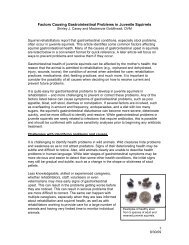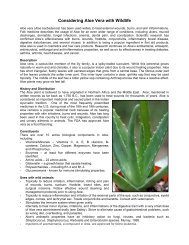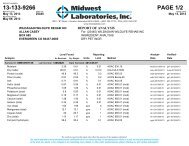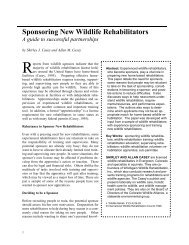printable PDF version - WildAgain Wildlife Rehabilitation
printable PDF version - WildAgain Wildlife Rehabilitation
printable PDF version - WildAgain Wildlife Rehabilitation
You also want an ePaper? Increase the reach of your titles
YUMPU automatically turns print PDFs into web optimized ePapers that Google loves.
‘New’ Esbilac® Powder and Juvenile Wild Mammal FormulasUpdate September 23, 2009<strong>WildAgain</strong> <strong>Wildlife</strong> <strong>Rehabilitation</strong> continues to collect information regarding the ‘new’Esbilac® powder manufactured after December, 2008. As with our other researchprojects, we try to provide information to the wildlife rehabilitation community that willsupport rehabilitators and their veterinarians in their decisions and practices.Key information in this update:- The ‘new’ Esbilac® weighs less and seems to have inadequate amounts ofenergy (kcals) and some nutrients required to meet the minimum needs of somejuvenile wild mammals.- Some rehabilitators report seeing positive results using the ‘new’ Esbilac®powder, particularly after adjusting the recipe to increase fats.- Other rehabilitators share that their juvenile squirrels and opossums are notimproving after adding more fats to the formula made with the ‘new’ Esbilac®powder or even switching to a new milk replacement product. Some of thesejuvenile squirrels and opossums, which stay at an extremely low weight for theirage, linger and then die.- Information on formula recipe changes, deciding on how to adjust formula, andevaluating formula recipes is discussed.- Cream now is included in the Nutrition Calculator. A short article about selectingcream for formulas is available.- A draft flow chart on the progression of formula problems and changes, and achart on possible causes and solutions are offered for reflection.- An increasing number of rehabilitators and veterinarians are conducting tests onthe wildlife that have fallen ill after eating formula made with the ‘new’ Esbilac®powder in hopes of finding answers.Esbilac® PowderReports continue that some rehabilitators are seeing great results when they makeformula for the juvenile wild mammals with the ‘new’ Esbilac® powder.However, even if their animals do not have the diarrhea reported by others, it isimportant to consider that the ‘new’ Esbilac® powder weighs less than it did in previousyears. The information on weights from previous years is available in our update ofSeptember 3, 2009. The ‘new’ Esbilac’s weight was provided by PetAg and confirmed byrehabilitators so we could calculate nutrients and kcals. It can be confirmed by weighingthe product on a precise and accurate digital gram scale. This reduced weight translatesinto reduced energy (kcals) and nutrients in the ‘new’ Esbilac® powder when comparedto the former Esbilac product.Adjusting the formula recipeJuvenile wild mammals have nutritional and dietary needs specific to their species.These needs also can be influenced by various factors, such as age and health. <strong>Wildlife</strong>rehabilitators who feed young mammals must understand the nutritional needs of theanimal based on a milk composition analysis for that species. The commercial milk1
single study in 1970 to 12-13% from two studies of multiple animals in 1962 and 1972. Itis uncertain at what period in lactation the milk was sampled. Squirrel rehabilitatorsaware of these basic nutritional requirements responded by adding an extra ¼ part to ½part whipping cream or ¼ part or ½ part MultiMilk® to a formula made with the ‘old’Esbilac® powder or Zoologic 33/40 powder in order to increase the fat levels fororphaned juvenile squirrels with their eyes opened. At this age, squirrels need, and areable to digest, the higher levels of fats. Thousands of squirrels of different speciesthrived on those augmented formulas because they met the animal’s nutrition, energy(kcal) and calcium-phosphorus requirements.It therefore is essential to consider how the nutrition requirements of proteins, fats,solids, energy (kcals) and calcium/phosphorus ratio are met every time that the formulais changed, whether the changes are in amounts or percentages – or even changing thenumber of feedings or amounts fed. Most rehabilitators, however, are reluctant toperform the complex mathematical calculations required to get these numbers.The <strong>WildAgain</strong> Nutritional Calculator makes it easy to do the math and see the affects ofdietary changes on paper (note that even if these changes look good on paper, they stillneed to be evaluated for their affects on the animal’s health and growth).This downloadable Excel-based Calculator has equations for PetAg products, includingthe ‘new’ and ‘old’ Esbilac powders, Zoologic products, MultiMilk® and KMR. Just type inthe number of ‘parts’ of these ingredients and it calculates the fats, solids,calcium/phosphorus and kcals for you. The Nutrition Calculator has been expanded toinclude not only both the ‘new’ and ‘old’ Esbilac, but now also has the ability to useweights instead of just parts and assess several different types of creams. To get evenmore accuracy, weigh your own products (e.g., ‘new’ Esbilac, water) and use thoseinstead of the default weights. Take a few minutes to try it out! It can be fun do thecalculations this way.Other milk replacer products will be added to the Calculator when their manufacturersrespond to our requests for the necessary nutritional analyses and ingredient lists.Evaluating formula recipe changesMeasuring and adding different amounts of supplemental ingredients to a milkreplacement formula may seem fairly easy. However, knowing exactly how to change aformula and then evaluating the short and long-term results is far more difficult. Smallchanges can have major affects! For example, while it is a relief to see normal stool inan animal that has suffered diarrhea, rehabilitators also must consider levels ofhydration, activity, elimination (stool and urine), appetite, and much more. Rehabilitatorsmust ask if an altered or supplemented milk replacement product fully and optimallysupports the animal’s health, wellbeing, and ability to survive when released back to liveindependently in the wild.It is critical to consider growth rate, development, bone health, teeth, fur/pelage, activity,overall health, ability to live and survive in the wild, and more over a much longer timeframe of months or years. It also is essential to monitor and document this with multipleanimals and species with preferably different locations and rehabilitators. The resultsthen must be compiled, analyzed, shared and compared with those of previous years,other diets and other rehabilitators. These are things that we all will have to do as3
individuals and as a larger rehabilitation community as we seek to change a diet that hasbeen used successfully for many years.A paper titled, Mammal Nutrition: More than a Cookbook, presented at the NWRAConference and published in their Conference Proceedings (2001) is available to helpwith this process.Selecting a fat to add to the formulaAs rehabilitators ask questions about the causes of diarrhea in their juvenile wildmammals, they have reexamined ingredients in the products that make up the formula.One of the things they have learned is that the animal fat in MultiMilk® is not butterfat asmany assumed, but rather lard (pork fat). Some rehabilitators plan to continue addingMultiMilk® since it has been used successfully with thousands of animals since 1993.Others, however, now are changing to the addition of a small amount of whipping creamto the formula like some rehabilitators have done for years. A short article aboutconsiderations when using cream to enhance wildlife formulas has been posted. Moreinformation on types of fats and their impact both on formula and juvenile mammals willbe available later.Chart of case progressionAs mentioned, some rehabilitators are sharing positive results with their mammals incare when adding whipping cream or MultiMilk® to formula made with the ‘new’ Esbilac®powder. Other rehabilitators have continued to observe diarrhea and a variety of otherhealth problems in their juvenile squirrels even after adding whipping cream orMultiMilk® to a formula mixed with 1 or 1.1 parts ‘new’ Esbilac® powder and 2 partswater. Some have shared that the problems persist even after changing to a differentmilk replacement formula.<strong>WildAgain</strong> has drafted a flow chart of information that has been shared with usconcerning the progression of problems in juvenile tree squirrels and opossums whenfed the ‘new’ Esbilac® powder. The chart was developed from many rehabilitator reportsof numerous cases across the US this summer. After these rehabilitators first tried toidentify and eliminate a variety of causes, they found that the ‘new’ Esbilac® powder wasoften the common factor. Still, it is possible that other factors or concurrent conditionsmay have contributed to, or caused, the observed problems. This draft chart is intendedto help wildlife rehabilitators figure out what is happening and where more information isneeded. It does not to draw conclusions or make recommendations. Link.The green boxes on the chart’s top are for animals that are healthy and growing when asupplement is added to the formula made with the ‘new’ Esbilac® powder. The pinkboxes below show other possible actions and results.Note the box in the lower left quadrant of the chart shows that some animals havedeveloped urinary symptoms. Rehabilitators reporting these symptoms say that they firstthought wet abdomens were the result of diarrhea, but soon realized that the wetnessactually was caused by involuntary urination. It still is unclear if urinary problems are asecondary infection that occurred after, or is due to, the diarrhea or was somehowcaused by the formula. The possibility of other factors, such as the Bordatella bacteriathat can cause involuntary urination and renal failure in squirrels, also should be4
evaluated. These considerations presently are being studied. If you have seen urinaryor other symptoms possibly related to using the new Esbilac, or have additional testresults, please email them to us at wlrehabproject@aol.com.More reflection on causes and adjustmentsRehabilitators keep asking if the formula made with the ‘new’ Esbilac® powder can beeasily fixed or if they should switch to a different milk replacement product, such asZoologic 33/40, Goat’s Milk Esbilac, Fox Valley Nutrition’s formulas. These questionsprompted another chart that shows some of the considerations in making that decision.This draft chart is titled “Possible Causes and Actions with Juvenile Wild Mammals whenUsing Esbilac® Powder made after 12/08”.The chart shows changes, possible issues and potential corrective actions. Boxes ingreen indicate things that are factual and relatively easy to change. The pink boxessuggest some additional questions and concerns. Like the first chart, this onedemonstrates that more research is needed.Increasing numbers of rehabilitators are having animal blood and urine tested, as well ashaving culture sensitivities, necropsies and other tests performed. We hope that thoseresults will help us all understand the causes, impacts, and solutions.Thanks and next stepsLast, a huge thanks to rehabilitators, veterinarians and others who have sharedinformation, cases, suggestions, and general support for this team effort to help the wildanimals in our collective care.We continue to gather information and will share it on a regular basis. If you haveadditional input on symptoms or test results, such as from stool culture sensitivities,blood work or necropsies, we would appreciate your contacting us so that theinformation may be consolidated, trends analyzed, and data shared. The info can beemailed to us at wlrehabproject@aol.comResourcesCasey, Allan. 2002. Mammal Nutrition: How Cookbooks Can Be Harmful. <strong>Wildlife</strong><strong>Rehabilitation</strong>, Vol. 19. NWRA Symposium: Selected Papers. NWRA, St. Cloud, MN.Casey, Shirley and Allan Casey. 2003. Squirrel <strong>Rehabilitation</strong> Handbook. <strong>WildAgain</strong><strong>Wildlife</strong> <strong>Rehabilitation</strong>: Evergreen, CO. Available at www.ewildagain.orgMoore, Adele and Joosten, Sally. 2002. NWRA Principles of <strong>Wildlife</strong> <strong>Rehabilitation</strong>, 2 ndEdition. NWRA, St. Cloud, MN.Nutrition calculator. Provides nutrition and kcal information on milk replacement productsand a downloadable calculator in Excel for easy use. Download atwww.ewildagain.org.<strong>WildAgain</strong> <strong>Wildlife</strong> <strong>Rehabilitation</strong>, Inc. 2005. Mammal Nutrition: Good <strong>Wildlife</strong> Nutrition isCritical. http://www.ewildagain.org/Nutrition/nutrition.htm5
AuthorsAllan and Shirley Casey, co-founders of <strong>WildAgain</strong> <strong>Wildlife</strong> <strong>Rehabilitation</strong>, Inc. inEvergreen, Colorado, have been licensed rehabilitators since 1986. The Casey’sconduct research on a variety of rehabilitation related subjects, including nutrition,wildlife health, rehabilitation regulations, and trends. They have written over 100 articlesfor rehabilitation and veterinary publications, as well as the Squirrel <strong>Rehabilitation</strong>Handbook. www.ewildagain.org© 2009 <strong>WildAgain</strong> <strong>Wildlife</strong> <strong>Rehabilitation</strong>, Inc.6


